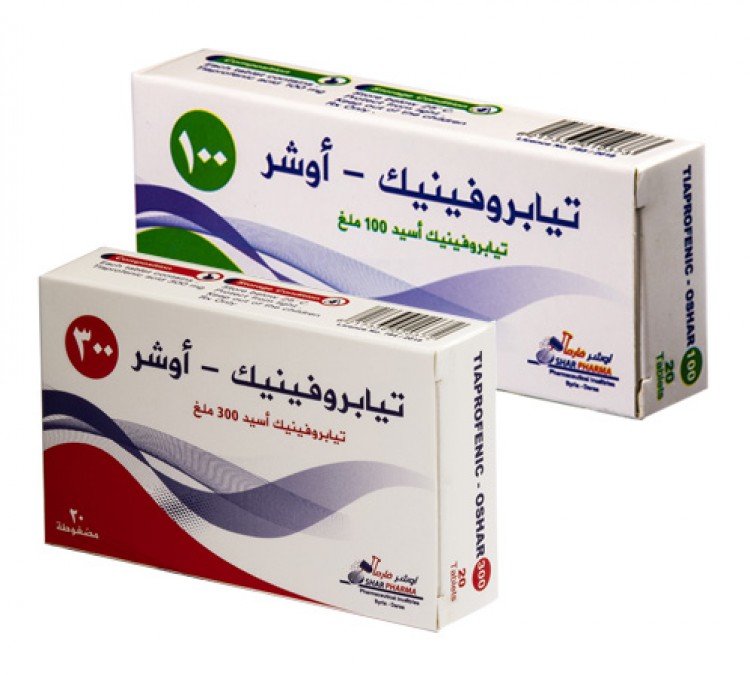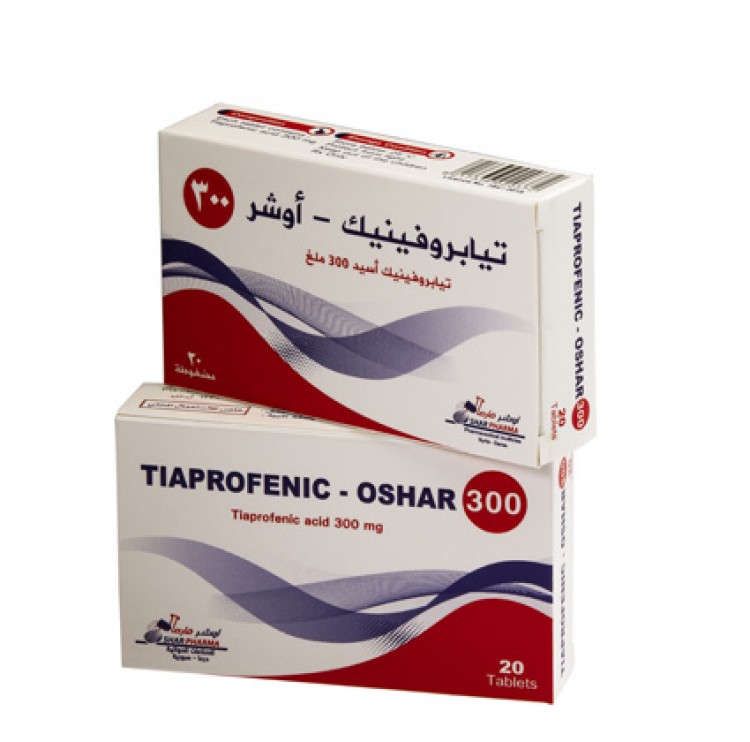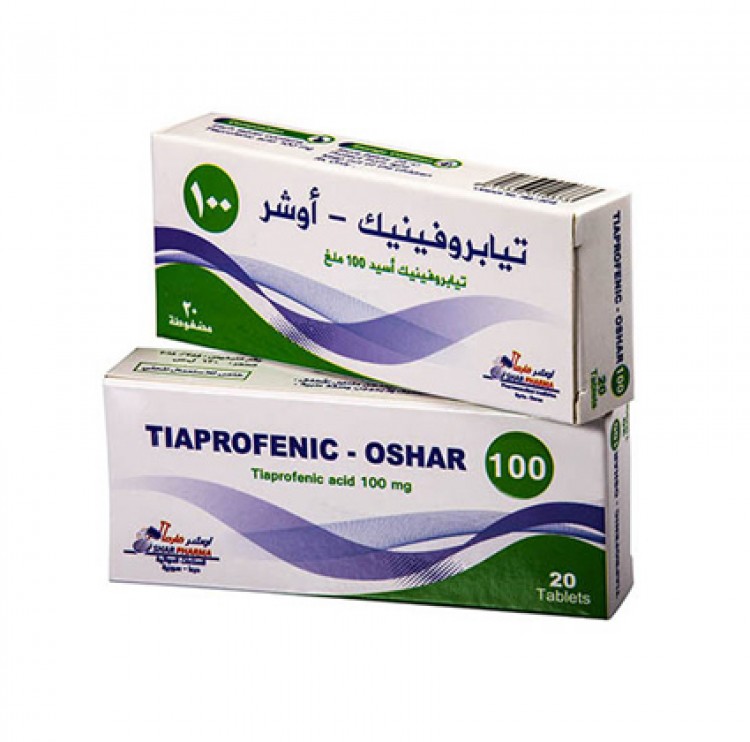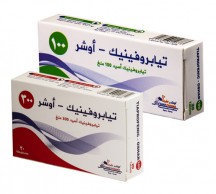Tiaprofenic Oshar 300 mg - 100 mg
Rheumatoid arthritis, osteoarthritis, ankylosing spondylitis, low back pain, musculo-skeletal disorders such as fibrositis, capsulitis, epicondylitis and other soft-tissue inflammatory conditions, sprains and strains, post-operative inflammation and pain and other soft tissue injuries.
Composition
CHEMICAL COMPOSITION :Each tablet contains 100 mg or 300 mg Tiaprofenic acid.
Excipients : Maize starch, poloxamer, sodium starch glycolate, magnesium stearate, Talc.
Usage
Rheumatoid arthritis, osteoarthritis, ankylosing spondylitis, low back pain, musculo-skeletal disorders such as fibrositis, capsulitis, epicondylitis and other soft-tissue inflammatory conditions, sprains and strains, post-operative inflammation and pain and other soft tissue injuries.
CONTRAINDICATIONS:
- Active or history of recurrent peptic ulcer/hemorrage (two or more distinct episodes of proven ulceration or bleeding).
- History of gastrointestinal bleeding or perforation, related to previous NSAIDs therapy.
- Active bladder or prostatic disease or symptoms.
- History of recurrent urinary tract disorders.
- Hypersensitivity to tiaprofenic acid or to any of the excipients.
- NSAIDs are contraindicated in patients who have previously shown hypersensitivity reactions (e.g. asthma, rhinitis, angioedema or urticaria) in response to ibuprofen, aspirin, or other non-steroidal anti-inflammatory drugs.
- During the last trimester of pregnancy.
- Severe heart failure, hepatic failure and renal failure.
PREGNANCY & LACTATION:
Pregnancy:
Congenital abnormalities have been reported in association with NSAID administration in man; however, these are low in frequency and do not appear to follow any discernible pattern. Tiaprofenic acid crosses the placental barrier. Although animal studies have not revealed evidence of teratogenicity, safety in human pregnancy and lactation cannot be assumed and, in common with other NSAIDs, tiaprofenic acid should not be used during the first two trimesters of pregnancy or labour unless the potential benefit to the patient outweighs the potential risk to the foetus.
In view of the known effects of NSAIDs on the foetal cardiovascular system (a closure of ductus arteriosus), use in the last trimester of pregnancy is contraindicated. The onset of labour may be delayed and the duration increased with an increased bleeding tendency in both mother and child.
Lactation:
The level of tiaprofenic acid in mother's milk has been studied and the total daily exposure is very small; approximately 0.2% of the administered dose and is unlikely to be of pharmacological significance. Breast feeding or treatment of the mother should be stopped as necessary.
EFFECTS ON ABILITY TO DRIVE AND USE MACHINES:
Undesirable effects such as dizziness, drowsiness, fatigue and visual disturbances are possible after taking NSAIDs. If affected, patients should not drive or operate machinery.
Side Effects
Gastrointestinal disorders:
Reported reactions include dyspepsia, nausea, vomiting, abdominal / upper abdominal pain, melaena, haematemesis, anorexia, indigestion, heartburn, disorders of intestinal transit (flatulence, diarrhoea, constipation), gastritis, ulcerative stomatitis, exacerbation of colitis and Crohn's disease. Pancreatitis has been reported very rarely.
Peptic ulcers, occult or active gastrointestinal haemorrhage and perforation have occasionally been reported, particularly in the elderly, and in exceptional case may have been associated with fatalities.
Skin and subcutaneous tissue disorders:
Rash, urticaria, pruritus, purpura, alopecia and erythema multiforme and dermatitis bullous (Stevens-Johnson Syndrome or toxic epidermal necrolysis), photosensitivity reactions have been reported.
Immune system disorders:
Hypersensitivity reactions have been reported following treatment with NSAIDs.
Non-specific allergic reactions, asthma, especially in subjects allergic to aspirin and other NSAIDs, bronchospasm, dyspnoea, angio-oedema, anaphylactic shock has also been reported.
Blood and lymphatic system disorders:
Thrombocytopenia , prolonged bleeding time, anemia due to bleeding may occur.
Ear and labyrinth disorders: Vertigo, dizziness, tinnitus and drowsiness.
Nervous system disorders: Headaches.
Renal and urinary disorders:
- bladder pain, dysuria, and pollakiuria.
- hematuria or cystitis may occur.
- after continuous, prolonged treatment with tiaprofenic acid in presence of urinary symptoms, inflammatory changes to the urinary tract, sometimes severe, have been observed.
- sodium and water retention.
- NSAIDs have been reported to cause nephrotoxicity in various forms. As with other NSAIDs, isolated cases of interstitial nephritis, nephrotic syndrome and renal failure have also been reported with tiaprofenic acid.
Hepatobiliary disorders: Hepatitis, jaundice.
| Properties | Mode of Action: Tiaprofenic acid displays analgesic, anti-inflammatory and anti-pyretic activity. Classical pharmacological studies in animals both in vitro and in vivo have shown that tiaprofenic acid inhibits the biosynthesis of prostaglandins, and is a non-selective antagonist of bradykinin, prostaglandin E2, serotonin, histamine and acetyl-choline. Further animal experiments have shown that these actions produce analgesic, anti-inflammatory and antipyretic effects. Tiaprofenic acid exhibits its anti-inflammatory effect even on adrenalectomised animals, indicating that its action is not mediated through the pituitary adrenal axis. Results of most in vitro studies in animal models, using articular cartilage explants and chondrocyte cultures, indicate that tiaprofenic acid does not depress biosynthesis of proteoglycans. In vitro studies with animal and human tissue provide evidence of inhibition of proteoglycan degradation by tiaprofenic acid. These results suggest that a positive effect on the joint cartilage may be expected, but in vivo effects and the clinical significance of the findings are yet to be clarified. Pharmacokinetic properties: Single dose studies: Following oral administration .Plasma level zero at 24 hours. t½ = 1.5 to 2 hours. Repeated dose studies: tiaprofenic acid is rapidly eliminated and there is no accumulation after repeated doses of 600mg/day in divided doses. Steady state after first day. No impairment of absorption in patients with RA undergoing long term therapy. There is no evidence of different pharmacokinetics in the elderly. Protein Binding = 97 - 98%. Plasma clearance = 6 litres/hour. Metabolites = there two main metabolites which account for about 10% of urinary excretion and have low pharmacological activity. The parent compound is excreted mostly in the form of acylglucuronide.
|
|---|---|
| Dosage | DOSAGE AND ADMINISTRATION: For oral administration. To be swallowed whole. To be taken preferably with or after food. Adults: 600 mg daily in divided doses. 300mg twice a day. Alternatively 200mg three times a day. Elderly: As for adults, NSAIDs should be used with particular caution in older patients who are at increased risk of the serious consequences of adverse reactions. In cases of renal, cardiac or hepatic impairment, the dosage should be kept as low as possible. It is suggested that in such cases, the dosage be reduced to 200 mg twice daily. If an NSAID is considered necessary, elderly patients should receive the lowest effective dose for the shortest possible duration and be monitored regularly for gastrointestinal bleeding for following initiation of NSAID therapy. Children: There are insufficient data to recommend use of tiaprofenic acid in children. Undesirable effects may be minimised by using the lowest effective dose for the shortest duration necessary to control symptoms. OVERDOSAGE: In the event of overdosage with tiaprofenic acid, supportive and symptomatic therapy is indicated. a) Symptoms Symptoms include headache, nausea, vomiting, epigastric pain, gastrointestinal bleeding, rarely diarrhoea, disorientation, excitation, coma, drowsiness, dizziness, tinnitus, fainting, occasionally convulsions. In cases of significant poisoning acute renal failure and liver damage are possible. b) Therapeutic measure Patients should be treated symptomatically as required. Within one hour of ingestion of a potentially toxic amount, activated charcoal should be considered. Alternatively, in adults, gastric lavage should be considered within one hour of ingestion of a potentially life-threatening overdose. Good urine output should be ensured. Renal and liver function should be closely monitored. Patients should be observed for at least four hours after ingestion of potentially toxic amounts. Frequent or prolonged convulsions should be treated with intravenous diazepam. Other measures may be indicated by the patient's clinical condition.
|
| Drug interactions | DRUG INTERACTION: Heparin, Hypoglycaemic agents and Diuretics: Since tiaprofenic acid is highly protein-bound, it is not recommended for co-administration with other highly protein-bound drugs such as heparin. Modification of the dosage may be necessary with hypoglycaemic agents, phenytoin and diuretics. With oral hypoglycaemic agents, an inhibition of metabolism of sulphonylurea drugs, prolonged half-life and increased risk of hypoglycaemia has been reported. Anticoagulants and antiplatelet agents: It is considered unsafe to take NSAIDs in combination with anticoagulants (i.e. heparin, warfarin) and platelet aggregation inhibitors (i.e. ticlopidine, clopidogrel) due to increased risk of bleeding. If coadministration is unavoidable, patient should be closely monitored. Other analgesics including cyclooxygenase-2 selective inhibitors: Concomitant use of tiaprofenic acid with other NSAIDs (including cyclooxygenase-2 selective inhibitors) and high-dose salicylates should be avoided due to an increased risk of adverse effects, particulary upper gastrointestinal disorders. Corticosteroids: Caution must be exercised when tiaprofenic acid is administered with corticosteroids due to increased risk of gastrointestinal ulceration or bleeding. Cardiac glycosides and sulphonamides: Caution should be exercised when tiaprofenic acid is administered with cardiac glycosides and sulphonamides. With cardiac glycosides, NSAIDs may exacerbate cardiac failure, reduce GFR and increase plasma cardiac glycoside levels. Methotrexate: Concomitant use of tiaprofenic acid with methotrexate causes a decreased elimination of methotrexate. Concomitant use with high dose methotrexate should be avoided. Use with caution with low dose methotrexate. Lithium: Decreased elimination of lithium. NSAIDs have been reported to increase steady state plasma levels of lithium and it is, therefore, recommended that these levels are monitored in patients receiving Surgazor therapy. Mifepristone: Aspirin and other NSAIDs should not be used for at least 8-12 days after mifepristone administration as NSAIDs can reduce the effect of mifepristone. Diuretics: Caution must be exercised when tiaprofenic acid is administered with diuretics, it reduces both the diuretic and antihypertensive effect of diuretics and increase risk of renal impairment and/or hyperkalemia. Diuretics can increase the risk of nephrotoxicity of NSAIDs. Tacrolimus: Possible increased risk of nephrotoxicity when NSAIDs are given with tacrolimus. Zidovudine: Increased risk of haematological toxicity when NSAIDs are given with zidovudine. There is evidence of an increased risk of haemarthroses and haematoma in HIV(+) haemophiliacs receiving concurrent treatment with zidovudine and ibuprofen. ACE inhibitors and Angiotensin II Receptor Antagonists: Caution must be exercised when tiaprofenic acid is administered with ACE inhibitors and angiotensin II receptor antagonists, further deterioration of renal function, including possible acute renal failure, in patients with compromised renal function (e.g. dehydrated patients or elderly patients). The possibility of interaction must be taken into account with: -Thrombolytics: Increased risk of haemorrhage. - Anti-hypertensives agents (diuretics, beta-blockers, ACE-inhibitors, Angiotensin II Receptor Antagonists): Reduced activity of these drugs. This should be borne in mind in patients with incipient or actual congestive heart failure and/or hypertension. Selective serotonin reuptake inhibitors (SSRIs): The possibility of interaction must be taken into account with selective serotonin reuptake inhibitors (SSRIs) e.g. increased risk of gastrointestinal bleeding. Ciclosporin: The risk of nephrotoxicity may be increased if NSAIDs are given with ciclosporins. Quinolone antibiotics: Animal data indicate that NSAIDs can increase the risk of convulsions associated with quinolone antibiotics. Patients taking NSAIDs and quinolones may have an increased risk of developing convulsions. Aminoglycosides or probenecid: Care should also be taken if tiaprofenic acid is concomitantly administered with aminoglycosides or probenecid. Aminoglycosides may interact with NSAIDs to cause a reduction in renal function in susceptible individuals, decreased elimination of aminoglycoside and increased plasma concentrations. A reduction in metabolism and elimination of NSAIDs and metabolites has been observed with probenecid.
|
| precautions and precautions | WARNINGS & PRECAUTIONS: Undesirable effects may be minimised by using the lowest effective dose for the shortest duration necessary to control symptoms. Patients treated with NSAIDs long-term should undergo regular medical supervision to monitor for adverse events. The use of tiaprofenic acid with concomitant NSAIDs including cyclooxygenase-2 selective inhibitors should be avoided. Tiaprofenic acid should be used with caution in:
Respiratory disorders: Caution is required if administered to patients suffering from, or with a previous history of, bronchial asthma since NSAIDs have been reported to precipitate bronchospasm in such patients. Gastrointestinal bleeding, ulceration and perforation: GI bleeding, ulceration or perforation, which can be fatal, has been reported with all NSAIDs at anytime during treatment, with or without warning symptoms or a previous history of serious GI events. The risk of GI bleeding, ulceration or perforation is higher with increasing NSAID doses, in patients with a history of ulcer, particularly if complicated with haemorrhage or perforation, and in the elderly. These patients should commence treatment on the lowest dose available. Combination therapy with protective agents (e.g. misoprostol or proton pump inhibitors) should be considered for these patients, and also for patients requiring concomitant low dose aspirin, or other drugs likely to increase gastrointestinal risk. Patients with a history of GI toxicity, particularly when elderly, should report any unusual abdominal symptoms (especially GI bleeding) particularly in the initial stages of treatment. Caution should be advised in patients receiving concomitant medications which could increase the risk of ulceration or bleeding, such as oral corticosteroids, anticoagulants such as warfarin, selective serotonin-reuptake inhibitors or anti-platelet agents such as aspirin. When GI bleeding or ulceration occurs in patients receiving tiaprofenic acid, the treatment should be withdrawn. NSAIDs should be given with care to patients with a history of gastrointestinal disease (ulcerative colitis, Crohn's disease) as their condition may be exacerbated. Dermatological: Serious skin reactions, some of them fatal, including exfoliative dermatitis, Stevens-Johnson syndrome, and toxic epidermal necrolysis, have been reported very rarely in association with the use of NSAIDs. Patients appear to be at highest risk of these reactions early in the course of therapy, the onset of the reaction occurring in the majority of cases within the first month of treatment. tiaprofenic acid should be discontinued at the first appearance of skin rash, mucosal lesions, or any other sign of hypersensitivity. Impaired female fertility: The use of tiaprofenic acid may impair female fertility and is not recommended in women attempting to conceive. In women who have difficulties conceiving or who are undergoing investigation of infertility, withdrawal of Surgazor should be considered. Cardiovascular, Renal and Hepatic Impairment: The administration of an NSAID may cause a dose dependent reduction in prostaglandin formation and precipitate renal failure. Patients at greatest risk of this reaction are those with impaired renal function, cardiac impairment, liver dysfunction, those taking diuretics and the elderly. Renal function should be monitored in these patients. Cardiovascular and cerebrovascular effects: Appropriate monitoring and advice are required for patients with a history of hypertension and/or mild to moderate congestive heart failure as fluid retention and oedema have been reported in association with NSAID therapy. Clinical trial and epidemiological data suggest that use of some NSAIDs (particularly at high doses and in long term treatment) may be associated with a small increased risk of arterial thrombotic events (for example myocardial infarction or stroke). There are insufficient data to exclude such a risk for tiaprofenic acid. Patients with uncontrolled hypertension, congestive heart failure, established ischaemic heart disease, peripheral arterial disease, and/or cerebrovascular disease should only be treated with tiaprofenic acid after careful consideration. Similar consideration should be made before initiating longer-term treatment of patients with risk factors for cardiovascular disease (e.g. hypertension, hyperlipidaemia, diabetes mellitus, smoking). SLE and mixed connective tissue disease: In patients with systemic lupus erythematosus (SLE) and mixed connective tissue disorders there may be an increased risk of aseptic meningitis.
At the start of therapy, urine volume and renal function should be carefully monitored in patients with a history of hypertension, cardiac insufficiency, liver cirrhosis, or nephrotic syndrome, and in patients on diuretics. Urinary symptoms and cystitis have been reported with tiaprofenic acid and other NSAIDs. Tiaprofenic acid appears to have a greater propensity than other NSAIDs to generate reports of cystitis.Tiaprofenic acid can cause cystitis which may become severe if the treatment is continued after the onset of urinary symptoms. If urinary symptoms such as frequency, urgency, dysuria, nocturia or haematuria occur, tiaprofenic acid should be stopped immediately and urinalysis and urine culture performed. Before starting treatment with tiaprofenic acid, the patient should be asked to inform his/her physician of any urinary symptom. Patients should be warned about the onset of urinary symptoms which may suggest cystitis and are advised to stop taking the drug and seek medical advice if these occur.
As NSAIDs can interfere with platelet function, they should be used with caution in patients with intracranial haemorrhage and bleeding diathesis.
|
| Package | PACKAGING: A carton box contains 2 PVC/Aluminium blister strips containing 10 tablets STORAGE CONDITIONS: Store below 25°C - Protect from light, Keep out of the reach of children.
|




